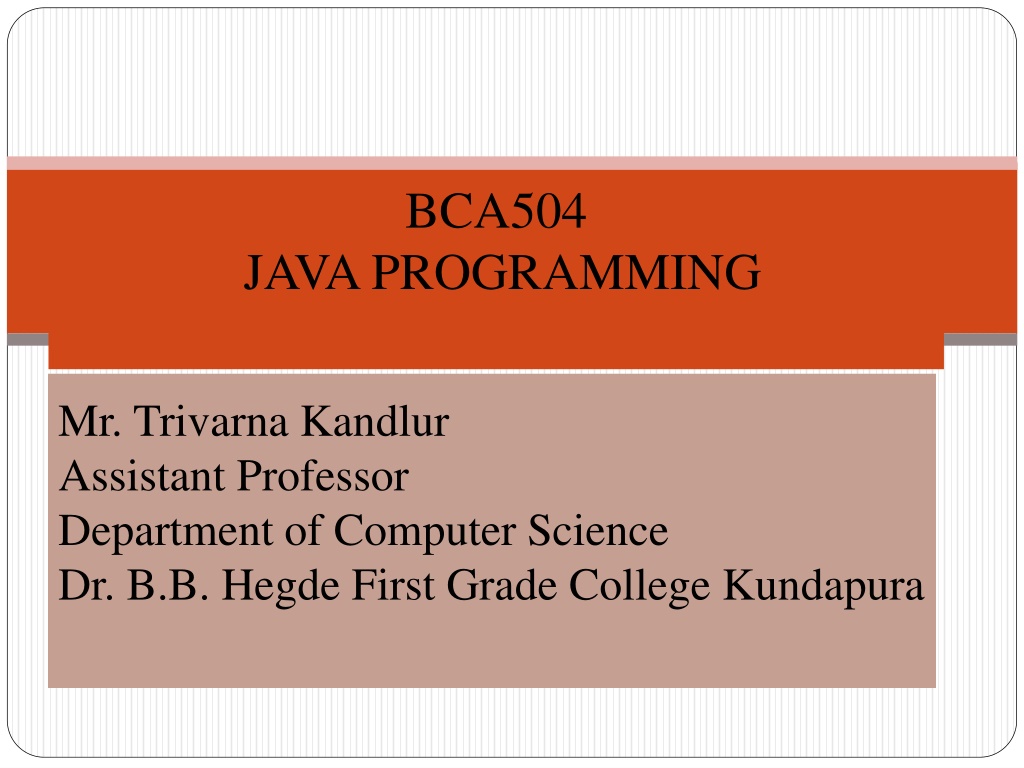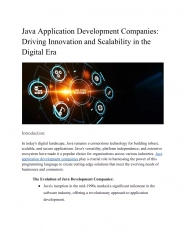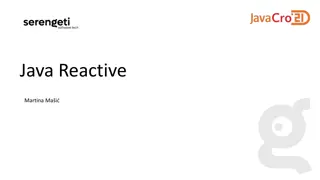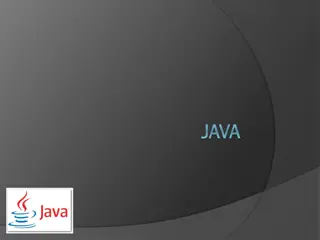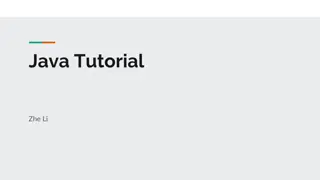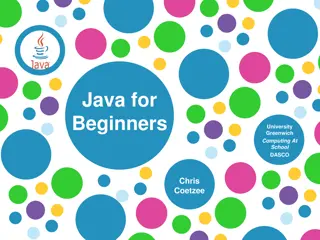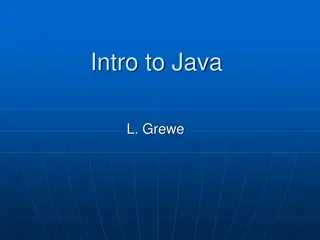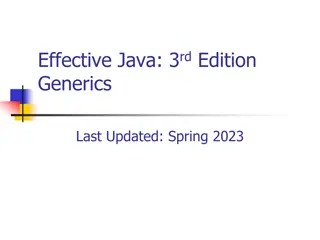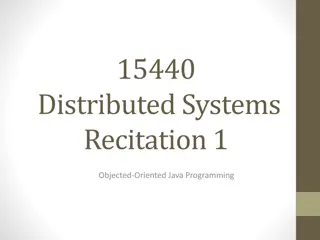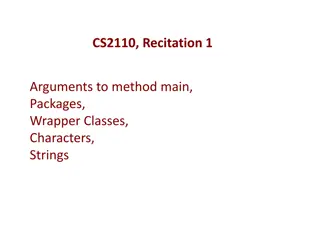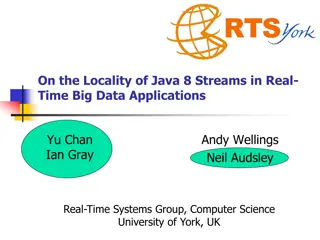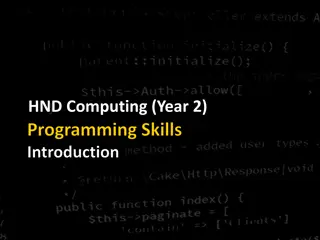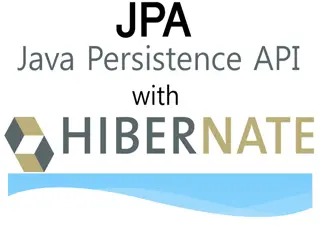Introduction to Java Programming: Basics and Applications
Java, developed by James Gosling, is a versatile object-oriented programming language used for mobile, desktop, web applications, servers, games, and more. It is renowned for its platform independence, popularity, ease of use, security, and strong community support. This subject delves into Java fundamentals, data types, I/O operations, control statements, and more, providing a comprehensive understanding of Java programming.
Download Presentation

Please find below an Image/Link to download the presentation.
The content on the website is provided AS IS for your information and personal use only. It may not be sold, licensed, or shared on other websites without obtaining consent from the author. Download presentation by click this link. If you encounter any issues during the download, it is possible that the publisher has removed the file from their server.
E N D
Presentation Transcript
BCA504 JAVA PROGRAMMING Mr. Trivarna Kandlur Assistant Professor Department of Computer Science Dr. B.B. Hegde First Grade College Kundapura
JAVA Java was conceived by James Gosling at Sun Microsystems in 1991. This language was initially called Oak but was renamed Java in 1995. Java is a Object Oriented(OOP) Programming language
It is used for: Mobile applications (specially Android apps) Desktop applications Web applications Web servers and application servers Games Database connection
Why Use Java? Java works on different platforms (Windows, Mac, Linux, Raspberry Pi, etc.) It is one of the most popular programming language in the world It is easy to learn and simple to use It is open-source and free It is secure, fast and powerful It has a huge community support (tens of millions of developers) Java is an object oriented language which gives a clear structure to programs and allows code to be reused, lowering development costs
About the Subject Subject Name : Java Programming Subject Code: BCA504 Number of Units: 4 Internal Assessment :20 marks External Exam :80 marks
Unit 1 Chapter 1 : Java Fundamentals: The origins of Java, Java s contribution to the internet, The Bytecode, The Java Buzzwords, Object Oriented Programming, Structure of a simple program, The Java Keywords, Identifiers in Java, The Java Class Libraries Chapter 2 : Data Types and Operators: Java s Primitive Types, Literals, Variables, The Scope and Lifetime of variables, Operators- Arithmetic Operators, Increment and Decrement Operators,, Relational and Logical Operators, Short-Circuit Logical Operators, The Assignment Operator, The Bitwise Operators, The Shift Operators, The ?: operator, Shorthand Assignments, Type Conversion in Assignments, Casting Incompatible Types, Operator Precedence, Expressions. Chapter 3 : Using I/O: Byte streams and character streams, predefined streams, reading console input, reading characters, strings, writing console output. Chapter 4: Control Statements: Input Characters from the Keyboard, The if statement, Nested ifs, The if..else..if Ladder, The switch statement, Nested switch statement, The for loop, The while Loop, The do..while Loop, break, continue, Nested Loops.
Unit 2 Chapter1: Arrays: One-Dimensional Arrays, Multidimensional Arrays,: Two Dimensional Arrays, Irregular Arrays, Initializing Multidimensional Arrays, Alternative Array Declaration Syntax, Assigning Array References, Using the length member, The For..Each Style for loop, Iterating Over Multidimensional Arrays, Applying the Enhanced for, Strings, Using Command-Line Arguments Chapter 2: Classes, Objects and Methods: Class Fundamentals, Creating Objects, Reference Variables and Assignment, Adding Methods, Returning from a Method, Returning a Value, Using Parameters, constructors, Parameterized Constructors, Adding a Constructor, The new operator, Garbage Collection and Finalizers, The finalize() method, The this keyword, Controlling Access to Class Members, Java s Access Modifiers, , Pass Objects to Methods, Returning Objects, Method Overloading, Understanding static: Static Blocks, Introducing Nested and Inner Classes, Variable-Length Arguments Chapter 3: Inheritance: Inheritance Basics, Member Access and Inheritance, Constructors and Inheritance, Using super to Call, Superclass Constructors, Using super to Access Superclass Members, Creating a Multilevel Hierarchy, call to the Constructors, Superclass References and Subclass Objects, Method Overriding, Overridden Methods Support Polymorphism, Use of Overridden Methods, Using Abstract Classes, Using final, The Object Class. Overloading Constructers, Recursion,
Unit 3 Chapter 1: Packages and Interfaces : Packages, Packages and Member Access, Understanding Protected members, Importing packages, Java s standard packages, Interfaces, Implementing Interfaces, Using Interface References ,Variables in Interfaces, Extending Interface. Chapter 2: Exception Handling: The Exception Hierarchy, Exception Handling Fundamentals, try and catch, The Consequences of an Uncaught Exception, Using Multiple catch statements, Catching Subclass Exceptions, nested try blocks, Throwing an Exception, Rethrowing an Exception, Using finally, Using throws, Java s Built-in Exceptions, Creating Exception Subclasses. Chapter 3: Multithreaded Programming : Multithreading fundamentals, The Thread Class and Runnable Interface, Creating a Thread, Creating Multiple Threads, Determining When a Thread Ends, Thread Priorities, Synchronization, Using Synchronized Methods, The synchronized Statement, Thread Communication Using notify(), wait() and notifyAll(), Suspending, Resuming, and Stopping Threads
Unit 4 Chapter 1: Applets, Events, and Miscellaneous Topics: Applet Basics, Applet Organization and Essential Elements, The Applet Architecture, A Complete Applet Skeleton, Applet Initialization and Termination,, Requesting Repainting-The update() Method, Using the Status Window, Passing parameters to Applets, The Applet Class ,Event Handling The Delegation Event Model, Events, Using the Delegation Event Model, More Java Keywords. Chapter 2: Using AWT controls, Layout managers and menus. Control Fundamentals - Labels, Buttons, CheckBoxes, CheckboxGroup, Choice Cotrols, Lists, Scroll Bars, TextField, TextArea. Layout Managers: FlowLayout,BorderLayout, GridLayout, Menu Bars and Menus Chapter 3: Introducing Swing: The Origins and Design Philosophy of Swing, Components and Containers, Layout Managers, Use Jbutton, Work with JTextField, Create a JCheckBox, Work with Jlist, Use anonymous inner classes to handle events, Create a Swing applet
Dr. B. B. Hegde First Grade College, Kundapura Department of Computer Science Lesson Plan: 2020-21 ( I Term) Class and Semester III BCA Subject and Code Teacher Date Java Programming Mr. Trivarna 29-05-2020 (BCA504) V Sem
Methodology/ Chapter Objectives Students Learning points Instructional techniques Lecturing Unit I: Java Fundamentals; Data types & operators; Using I/O; Control Statements. To study the origin of Java, The byte code, Java Buzzwords & The Java class libraries. To know about history of Java. chalk & talk method. To understand the concept of data types & operations of Java. Online Teaching To understand the data types used in Java & the different operators. To know the usage of I/O. To understand the control statements. To study the Byte stream & Character stream. To study the different control statements used in Java. To study the different types of arrays. UNIT II: Arrays; Classes, Objects & methods; Inheritance. Lecturing Make the students to understand arrays concept and usage of arrays. chalk & talk method. To study the class fundamental, creating objects & adding methods. Online Teaching To know about classes, objects and methods. To understand what is inheritance and where it is used. Make the students to understand the inheritance basics and usage of inheritance.
UNIT III: Packages and Interfaces; Exception handling; Multi threaded programming. To know the packages and understanding the interface. Lecturing To study the packages and interfaces. chalk & talk method. To study the exception hierarchy and exception handling fundamentals. To study the exception and exception handling. Online Teaching Make the students to understand multi threading concepts. To study the multi threading fundamentals, creating thread and creating multiple threads. UNIT IV: Applets, Events and Miscellaneous topics; Using AWT controls, layout managers and menus; Control fundamentals; Layout managers; Introducing swing. To understand the concept of Applet basics, Applet architecture and complete applet skeleton. Lecturing To make the students to understand the applet. chalk & talk method. To understand the concept of AWT controls, Layout managers, menus and the swing. Online Teaching To study the usage of AWT controls, layout managers and menus. To study the Introduction of swing and create a swing applet.
Text Books: Herbert Schildt, Java: A Beginner's Guide, 5th 1. Edition, Tata McGraw Hill Education Private Limited, 2011. Herbert Schildt, The Complete Reference Java, 7th 2. Edition, Tata McGraw Hill Publishing Company Limited. (Chapters: 13, 24)
Reference books: E Balagurusamy, Programming With Java: A Primer, 1. Tata McGraw Hill Education Private Limited, 2009 Junaid Khateeb and Dr. G T Thampi, Computer 2. Programming in Java, Dreamtech, 2011
